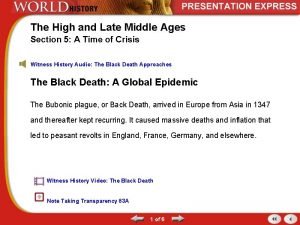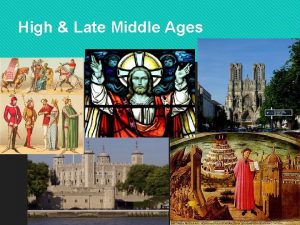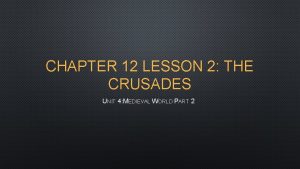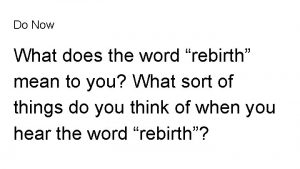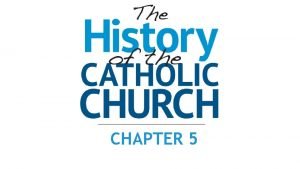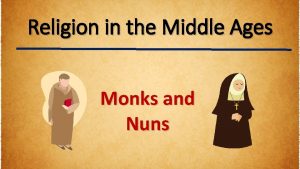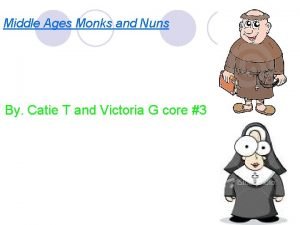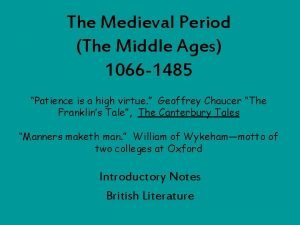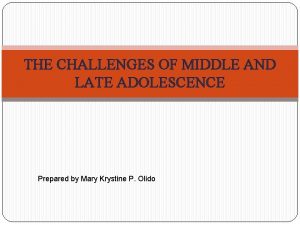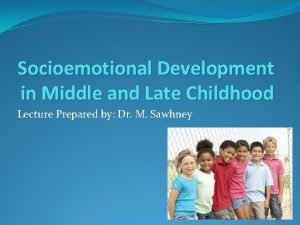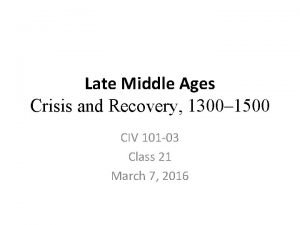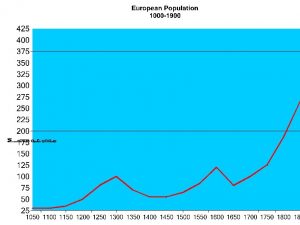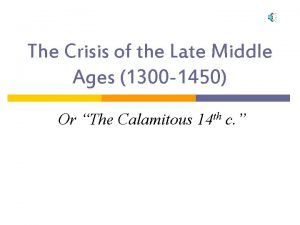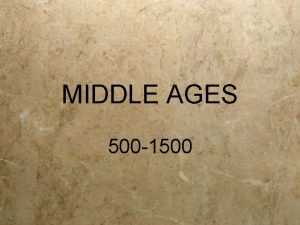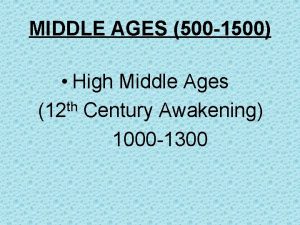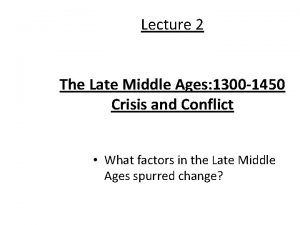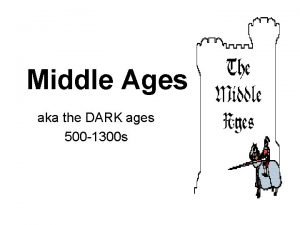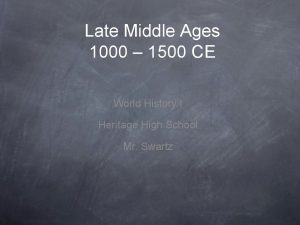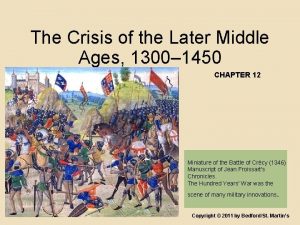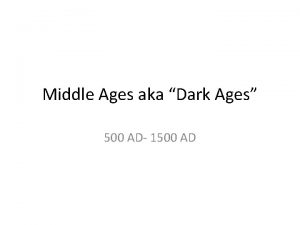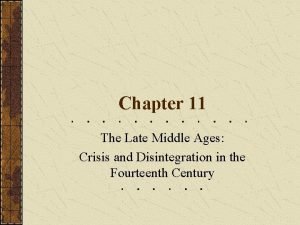Late Middle Ages Crisis and Recovery 1300 1500














- Slides: 14

Late Middle Ages Crisis and Recovery, 1300– 1500 CIV 101 -02 Class 29 November 2, 2015

They don’t call it the Dark Ages for nothing • Ordeal by Plague, Famine, and War – The Black Death – Failure of agricultural harvests – Struggles for control of southern Italy, northern Italy – The Hundred Years’ War • Competition between France and England – Ottoman Turks – Degradation of the Church • The separation of philosophy and theology and the hastening of secularization

Yet, Running Headlong toward the Renaissance • But don’t forget… and do notice when you read and study about this period – Every single guy involved in good stuff toward the Renaissance and New Science. . . Is a Roman Catholic Churchman – The Church was in the way, but was also THE WAY. • • Education Reasons to study Reasons to argue Reasons to innovate

Yet, Running Headlong toward the Renaissance • Spinning Wheel, improved cloth/clothing, and work process (“putting-out” system). – Silk and other fine cloth • Paper making – A variety of printing innovations, culminating in • The printing press (probably THE most important technological innovation, for the West, until the steam engine).

Running Headlong toward the Renaissance • Iron making (and forming) – Wrought iron uses smelted ore … has to be hammered, usually at high temps, to form the carbonized result (fairly strong). – At higher temps (short of a blast furnace) iron can be melted and cast… great for shaping, but the result is brittle. – In the late middle ages, smiths learned to pump air into layers of charcoal, limestone/crushed shells, and iron ore to make hotter fires (blast furnaces and machine driven “Forge hammers”) to work every sort of iron.

Running Headlong toward the Renaissance • Science: Headed toward Descartes – Working out faith & reason • Some of this is based on Arabic/Muslim advances • Some of this is in response to—against—the increasing irrelevance of Scholasticism • Some of this is due to re-discovery and translation of classics (again, aided by the Arabic/Muslim advances – Working toward developing the scientific method • Robert Grosseteste: adds math and physics and ARISTOTLE to reasoning. Specific to general/general to specific • Roger Bacon: FACTS first, reasoning after.

Running Headlong toward the Renaissance • Religion/Theology and Philosophy: Headed toward the Reformation – The Via Antiqua versus the Via Moderna • http: //plato. stanford. edu/entries/universals-medieval/#8 • Via Antiqua: posited a complex sets of relationships among objects, sets of objects, perceptions, beliefs, classifications/definitions. • Via Moderna: posited a more direct relation among object/perception/definition. • The Via Moderna view helped free scientific/philosophic thought from the shackles of Scholasticism and reasoning from received wisdom (opens the way for Descartes and new science.

Running Headlong toward the Renaissance – Duns Scotus • Univocity (that there abstract ideal forms– Plato’s truth) • Formal distinctions can be made among forms – William of Ockham: Faith and reason.

Running Headlong toward the Renaissance • THREE POPES (actually, 4 were elected): the Great Schism • contested election of Pope Urban VI in 1378 – He was “erratic” so they un-elected him • Selected Clement VII – Who Urban “excommunicated” – Clement moved to Avignon and got French support • After a third pope was chosen (Gregory VI, • the Council of Constance (1414 -1418) elected a new pope Martin V • The papacy (and the church) were never the same thereafter (ripe for reformation).

Running Headlong toward the Renaissance • Literature: esp. Chaucer (and others) – First 18 Lines of the “General Prologue, ” Canterbury Tales – https: //www. youtube. com/watch? v= 0 X 2 o. DRWnqwo – 1: 20 - 4: 33 – 3: 23 -4: 22 (you think THIS class is hard: the students taking this course have to MEMORIZE and recite this passage!)

Running Headlong toward the Renaissance • Machaut: Notre Dame Mass • Kyrie: 6: 13 -13: 14 – https: //www. youtube. com/watch? v=11 A 4 wqv 8 _wo&list=RD 11 A 4 wqv 8_wo#t=10

Running Headlong toward the Renaissance • Music: Chromatic scale, a 13 th century invention

Running Headlong toward the Renaissance • Art and Architecture – Late Gothic Sculpture

Running Headlong toward the Renaissance • Art and Architecture (continued) – Late Gothic Painting and the Rise of New Trends • • Illuminated Manuscripts The Print New Trends in Italy: Giotto Flemish Painting: Jan Van Eyck and Hans Memling • ALMOST PERSPECTIVISM – The rise of wealthy laymen as patrons of the arts
 The high and late middle ages section 5 quiz
The high and late middle ages section 5 quiz Why are the middle ages called the dark ages
Why are the middle ages called the dark ages Renaissance vs medieval art
Renaissance vs medieval art Late middle ages timeline
Late middle ages timeline High to late middle ages
High to late middle ages Chapter 12 lesson 2 world history
Chapter 12 lesson 2 world history Mean
Mean Similarities between middle ages and renaissance
Similarities between middle ages and renaissance Monks and nuns in the middle ages
Monks and nuns in the middle ages Nuns
Nuns Medieval time
Medieval time Myasthenic crisis vs cholinergic crisis ppt
Myasthenic crisis vs cholinergic crisis ppt Challenges of middle and late adolescence
Challenges of middle and late adolescence Socioemotional development in middle and late childhood
Socioemotional development in middle and late childhood Late childhood cognitive development
Late childhood cognitive development
